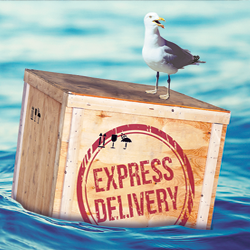|
exhibiting 101
 Ship Shape
Ensure your exhibit arrives intact and on time by heeding these seven shipping-related lessons.
Perhaps no other facet of trade show marketing is more prone to snafus and slip-ups than shipping an exhibit. So many variables, from the type of exhibit materials being sent to how the freight is packed, can derail the best plans. The following pointers – which should help you sidestep shipping-related glitches – represent some of the important lessons I've learned in the course of my career, as well as advice I've received from seasoned shipping professionals.
Pick the Proper Carrier Shipping exhibit materials to trade show venues is different than shipping anything anywhere else, in part because of the number, fragility, and size of the packages. The logistics of coordinating the shipping and arrival times to meet show deadlines, filling out all the paperwork, and managing the material-handling process further complicate the issue. Because of this, the first question to ask a potential carrier is what percentage of the company's sales comes from trade show exhibit shipments. I usually steer clear of a company that doesn't derive at least 50 percent of its sales from the trade show industry, and I typically look for a carrier that has a dedicated trade show division. Request a written copy of the carrier's procedures for problem solving in the event of lost or missing freight, damage, delays, etc. And ask about your shipping agent's availability in case of emergency. Transportation carriers' agents, brokers, and dispatchers should be available 24 hours a day, seven days a week. Personally, I won't ship with a company with which I don't have a "call anytime" cellphone number for somebody at the vice-president level. Additionally, ask any potential carriers to supply a few long-time exhibitor customers as references. Then contact these references and ask them how long they have been shipping with the carrier, how closely the carrier's quotes match the final invoices, what surprises (good or bad) they've experienced, and how the company has handled any mix-ups. Choosing your carrier is a mission-critical decision, so make sure you have all the info before you commit. Once you find a company you trust, stick with it. The stronger – and longer – your relationship, the more likely company reps are to go that extra mile to help when disaster strikes. Provide Adequate Information For each show, compile a spreadsheet of the exhibit components, graphics, carpet, products, equipment, literature, giveaways, and supplies that need to be shipped. Add columns for the quantity of each, how they will be packed (crated, in cases, loose boxes, or palletized), and their dimensions and estimated weight. Provide this list to your carrier so it can give you an accurate quote and reserve your shipping space on the truck or plane. Your carrier will also need to know the full name of the show (not just the acronym), your booth number, the show dates, your move-in and move-out dates, and whether these dates are targeted. Indicate if you will need special equipment, such as a lift-gate truck, stacking bars, J-bar, pallet jack, dollies, and/or moving pads. Tell your carrier whether a dock is available for loading, if there will be pick-ups or deliveries at multiple locations, and if you have pallets of multiple pieces that you don't want depalletized. If you have a map of the marshaling-yard location, pass that on, too. Determine the Destination Exhibit managers have two options for where to ship exhibits: 1) to an advance warehouse, where they receive 30 days of free storage, or 2) directly to the show site. Shipping to the advance warehouse gets your freight on the show floor before direct-to-show-site shipments begin unloading. This may save you money on storage expenses and transportation wait time. One limitation of the advance warehouse is that it does not accept pad-wrapped freight. Shipping to the advance warehouse also requires additional labor and equipment, which may raise your material-handling cost and create more risk for damage or loss during handling. Another liability is that exhibit materials are not always stored in an actual warehouse; they may be stored in unsecured trailers. Shipping direct to site allows you to avoid these risks, and it may be cheaper depending on warehouse labor rates. However, with direct-to-site shipments the time that your freight will unload is unpredictable and based on the check-in time of your truck, the efficiency of the marshaling process, and availability of docks with direct access to your booth space. You can also split your shipment and send some items to the advance warehouse and others direct to site. Some exhibitors ship their carpet, pad, and exhibit to the advance warehouse to gain extra setup time, and ship their products and other supplies direct to site since they generally won't need them until after the build. Don't Miss Deadlines Double check that your transportation team knows the last day to unload at the advance warehouse and/or the time of your targeted direct-to-site shipments. If your carrier misses the targeted deadline, the truck can be sent to the end of the line for unloading and may incur a financial penalty or be unloaded at overtime rates. The time the freight arrives at the booth can also affect installation costs. If it doesn't arrive in time for your setup crew to work on straight time, you may have to pay overtime rates for your labor. So include a margin of error in your shipping schedule if possible, as any number of hazards can delay your shipment. Anticipate All Expenses EXHIBITOR's most recent budgeting survey found that transportation accounts for roughly 12 percent of a company's overall trade show budget. But transportation can also affect other budget categories indirectly. For example, material-handling rates can vary based on the type of freight, carrier type, packaging, how the freight is loaded, and where and when it is unloaded. You can also incur extra special-handling charges for shipments requiring additional time, labor, or equipment to unload, so talk with your transportation carrier to make sure you are anticipating – and budgeting for – direct and indirect charges you are likely to face. Remember Crucial Paperwork There are two critical pieces of documentation that exhibitors need to understand. The bill of lading (B/L) establishes the contract terms between the exhibitor and its carrier to move its freight from pick-up to destination. The material-handling agreement (MHA) is the contract between the exhibitor and the general services contractor (GSC) allowing the GSC to move freight from a company's booth and relinquish it to the exhibitor's designated carrier for loading. If the MHA is not completed and turned in to the GSC's desk, your freight may be "forced" to the GSC's warehouse for storage pending further instructions or be shipped via the official shipping contractor at nondiscounted rates. Confirm Your Coverage Many inexperienced exhibit managers assume that if their freight is lost, the carrier can be held responsible. But in most cases, your carrier will only provide minimal valuation called "released value," which usually ranges from $0.30 to $0.60 per pound. If you need to cover the replacement value of your shipment the entire time it is on the road, you can purchase additional valuation from carriers in $1,000 increments. However, the most economical way to cover a shipment's value is to purchase "door-to-door" all-risk insurance as a rider to your corporate insurance policy. Work with your company's risk-management department to set the replacement value of your entire shipment and how much risk you want to assume with your deductible. Ultimately, you incur some risk every time you ship your freight. Even if you are insured for every penny of the shipment's value, losing it will cause anxiety and could have serious repercussions if you're forced to exhibit, well, without an exhibit. But these lessons will help you keep your program in ship shape and provide a little peace of mind in the process.
E
 Candy Adams
Candy AdamsCTSM, CEM, CMP, CMM "The Booth Mom," is an independent exhibit project manager, trainer, speaker, consultant, and an Exhibitor Conference faculty member. CandyAdams@BoothMom.com
|
|
|
||||||||||||||||||||||||||||
|
|
||||||||||||||||||||||||||||
|
TOPICS Measurement & Budgeting Planning & Execution Marketing & Promotion Events & Venues Personal & Career Exhibits & Experiences International Exhibiting Resources for Rookies Research & Resources |
MAGAZINE Subscribe Today! Renew Subscription Update Address Digital Downloads Newsletters Advertise |
FIND-IT Exhibit & Display Producers Products & Services Supplier to Supplier All Companies Compare Get Listed |
EXHIBITORLIVE Sessions Certification Exhibit Hall Exhibit at the Show Registration |
ETRAK Sessions Certification F.A.Q. Registration |
EDUCATION WEEK Overview Sessions Hotel Registration |
CERTIFICATION The Program Steps to Certification Faculty and Staff Enroll in CTSM Submit Quiz Answers My CTSM |
AWARDS Sizzle Awards Exhibit Design Awards Portable/Modular Awards Corporate Event Awards Centers of Excellence |
NEWS Associations/Press Awards Company News International New Products People Shows & Events Venues & Destinations EXHIBITOR News |
||||||||||||||||||||
|
||||||||||||||||||||||||||||






